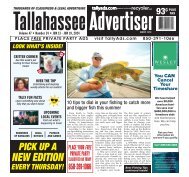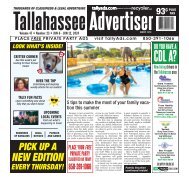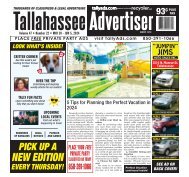TLA32_AllPages_R
Create successful ePaper yourself
Turn your PDF publications into a flip-book with our unique Google optimized e-Paper software.
warning signs, flashing lights and barricades to follow the<br />
devices’s verbal commands.<br />
Mullins has seen and heard the same from drivers he’s<br />
trained. “They’re so focused on listening to that voice,<br />
they’re not aware of their surroundings. Like there’s<br />
a low bridge coming up, or, wait a minute, this is a<br />
neighborhood, what’s a truck doing in a neighborhood?<br />
‘But the GPS says go this way.’ What about those big signs<br />
that say, ‘no trucks’?”<br />
Researchers have shown that the saying, “it isn’t the<br />
destination, it’s the journey that matters” takes on new<br />
meaning when it comes to GPS use and its effect on<br />
drivers. There are definite use-it-or-lose-it consequences<br />
from overreliance on the devices.<br />
In 2016, a study at University College London<br />
compared brain activity between drivers given turn-byturn<br />
instructions from a GPS and drivers using their own<br />
senses. The study found that when drivers used their own<br />
senses, there was a spike in activity in the hippocampus,<br />
the part of the brain responsible for navigation, and in<br />
the prefrontal cortex, the part of the brain responsible for<br />
planning. The spikes occurred literally at every turn and<br />
were more pronounced when the driver had more than<br />
two options.<br />
No such increase in brain activity was recorded in<br />
the drivers who simply followed GPS directions. And<br />
when these drivers were suddenly cut off from GPS<br />
instructions, their brains had not adequately monitored<br />
their progress and they were unable to immediately take<br />
over navigating.<br />
Other studies have indicated that the more people<br />
depend on technology to lead them around, the less they<br />
retain their natural ability to navigate on their own, much<br />
the way muscles weaken from lack of exercise.<br />
In a Japanese study done in 2008, scientists took three<br />
groups of drivers along a route, using either maps, GPS<br />
or no directional aid at all, then asked them to repeat<br />
the route on their own. The drivers who’d used GPS on<br />
GPS devices are a helpful navigational tool. But when<br />
people become so dependent on them that they blindly<br />
follow the machine’s instructions over what their own<br />
experience tells them and what’s right before their eyes,<br />
it can lead to big problems.<br />
the first run were not only outperformed by those who’d<br />
used a map, but by those who used memory alone.<br />
A 2006 study of London cab drivers who’d navigated<br />
that city’s complicated streets for years found these<br />
drivers had above-average development in the area of<br />
the brain that processes spatial representation. The study<br />
also suggested that this pumped-up part of the brain<br />
starts to diminish once the drivers retire.<br />
Roadmap to proficiency<br />
Researchers have found that one of the key problems<br />
with GPS is its focus on an A-to-B route. The driver’s task<br />
is reduced to doing what the voice tells him to do. Even<br />
the map on many GPS units will rotate in the direction<br />
the vehicle is going so there isn’t the directional northsouth-east-west<br />
consistency of a paper map. At this level<br />
of disengagement, the driver’s mind is prevented from<br />
developing what is called a cognitive map, a combination of<br />
instinct and intellect that humans normally use to find their<br />
way around.<br />
In the automotive age, cognitive mapping traditionally<br />
begins with studying an actual map, plotting out a route,<br />
noting the towns you’ll pass through, the natural and<br />
manmade landmarks you’ll encounter. Then, memory, vision<br />
and other cognitive functions all come into<br />
play while driving — reading the road signs,<br />
noting the landscape, creating your own<br />
mental landmarks — in the formation of the<br />
cognitive maps we create in our minds.<br />
Mullins’ advice to younger, beginning<br />
drivers is to take the time to learn how to use<br />
a map and an atlas along with your GPS.<br />
At CalArk, Stout said, it’s mandatory.<br />
“Education from the very beginning of<br />
employment is key. We do not offer GPS<br />
systems in our units, but even if we do at<br />
some point, map reading will still need to be<br />
a skill all of our drivers have,” she said.<br />
At some point, that GPS will make a<br />
Tca 2018 www.Truckload.org | TRUCKLOAD AUTHORITY 23

















